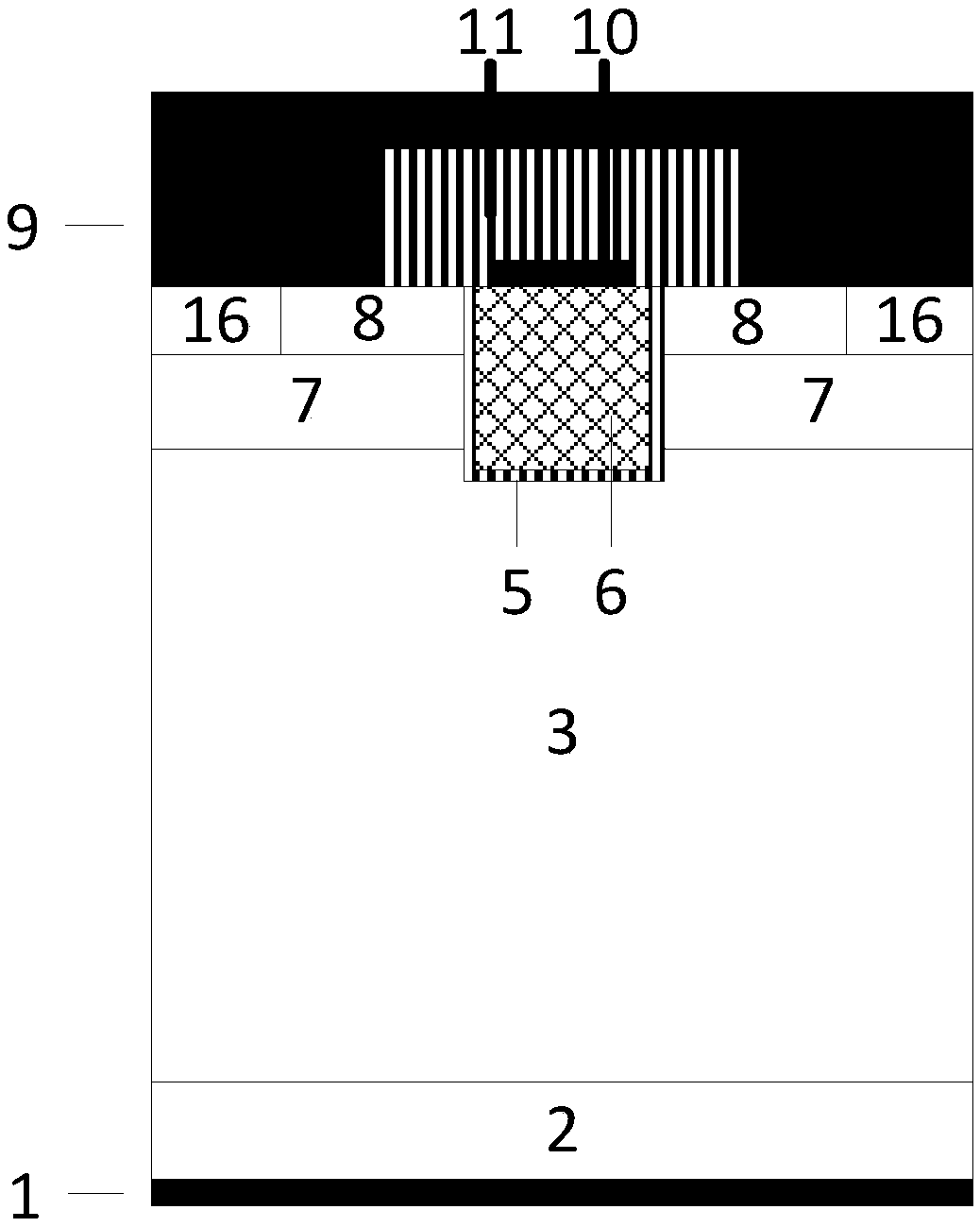A silicon carbide MOSFET device and a manufacturing method thereof
A silicon carbide and device technology, which is applied in semiconductor/solid-state device manufacturing, semiconductor devices, electrical components, etc., can solve problems such as low work efficiency, high production cost, and high power loss
- Summary
- Abstract
- Description
- Claims
- Application Information
AI Technical Summary
Problems solved by technology
Method used
Image
Examples
Embodiment 1
[0126] A silicon carbide MOSFET device, the cell structure of its basic structure is as follows figure 2 shown. Including drain metal 1, silicon carbide N arranged sequentially from bottom to top + Substrate 2 and SiC N - epitaxial layer 3; the silicon carbide N - There is a source trench on the upper left of the epitaxial layer 3, and the source trench is deposited and filled with Schottky contact metal 12; there is a silicon carbide deep P-doped region 4 below the Schottky contact metal 12; the Schottky contact metal 12 with SiC N - The epitaxial layer 3 is in direct contact with the sidewall at the bottom of the trench to form a Schottky contact with rectification characteristics, and the silicon carbide N - There is a silicon carbide deep P-doped region 4 on the upper right of the epitaxial layer 3, and its depth is the same as that of the silicon carbide deep P-doped region 4 below the Schottky contact metal 12; the silicon carbide N - The upper left of the silicon ...
Embodiment 2
[0128] This embodiment makes a certain degree of modification to embodiment 1, and its structure is roughly the same as embodiment 1, the difference is that the Schottky contact metal 12 region used is replaced by polysilicon 13, as image 3 shown. Also, a Si / SiC heterojunction structure with a rectifying contact is formed on the bottom sidewall of the source trench and the silicon carbide N- epitaxial layer 3 . The forward conduction voltage drop Von of the heterojunction structure is about 1.1V, which also has a greater effect on the operation of the third quadrant of the device. At the same time, since the heterojunction is a multi-sub-device, the diode has good reverse recovery performance.
Embodiment 3
[0130] The difference between this embodiment and Embodiment 1 is that the Schottky contact metal 12 has a larger lateral dimension, such as Figure 4 As shown: the right side of the Schottky contact metal 12 exceeds the right boundary of the silicon carbide deep P-doped region 4, not only the bottom sidewall is in contact with the silicon carbide N- epitaxial layer 3, but also the bottom part of the region is in contact with the silicon carbide N - Epitaxial layer 3 contacts. The larger width of the Schottky contact metal 12 increases the contact area of the Schottky junction, which has further significance for the optimization of the third quadrant of the device.
PUM
| Property | Measurement | Unit |
|---|---|---|
| thickness | aaaaa | aaaaa |
| width | aaaaa | aaaaa |
| width | aaaaa | aaaaa |
Abstract
Description
Claims
Application Information
 Login to View More
Login to View More - R&D
- Intellectual Property
- Life Sciences
- Materials
- Tech Scout
- Unparalleled Data Quality
- Higher Quality Content
- 60% Fewer Hallucinations
Browse by: Latest US Patents, China's latest patents, Technical Efficacy Thesaurus, Application Domain, Technology Topic, Popular Technical Reports.
© 2025 PatSnap. All rights reserved.Legal|Privacy policy|Modern Slavery Act Transparency Statement|Sitemap|About US| Contact US: help@patsnap.com



